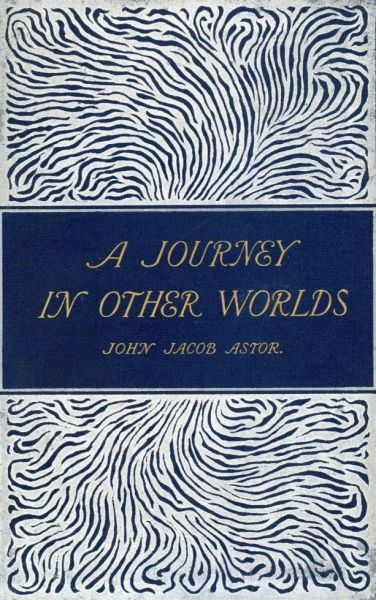‘Til All Success Be Nobleness
A Journey in Other Worlds
By John Jacob Astor IV

21 Feb, 2023
John Jacob Astor IV’s 1894 A Journey in Other Worlds is a stand-alone science fiction novel about a journey to Jupiter and Saturn.
In the year 2000, Anglo-Saxon prowess and fecundity have transformed America into an advanced, electrified multi-continental power that spans the Americas and Africa. The Terrestrial Axis Straightening Company is busily engaged in the great work of re-adjusting the Earth’s axial tilt to better suit American needs. Things are going well. It is the perfect time for a party of bored adventurers to set out for Jupiter and Saturn in an apergy-propelled1spacecraft.
Aboard the potentially confusingly named Callisto2: Terrestrial Axis Straightening Company President Bearwarden, Dr. Cortlandt, and young Ayrault. Each has good reason to be aboard; for Ayrault the journey will fill the time before his beautiful fiancée is old enough for the pair to marry3.
The product of good old American know-how, Callisto has little trouble taking the trio on a tour of the Solar System between Earth and Jupiter. Once arrived at the giant planet, the space ship conveys its passengers safely to the ground. Having landed, the travellers waste no time before engaging in the two great pastimes of manly American men: shooting wildlife while lecturing each other at great length.
Having established that Jupiter is a paradise suitable to relieve American population pressure (in a hundred years or so, when South America and Africa are too full of Anglo-Saxons) and having in the process reduced considerably the number of living animals on Jupiter, the trio head further out for Saturn.
Like Jupiter, Saturn is a world of wonders. However, Saturn has features Jupiter lacks. Saturn, you see, is one of the destinations for the souls of the dead. The dead have much they would like to relate to the travellers.
~oOo~
John Jacob Astor IV may be better known for having scandalously divorced his first wife, Ava Lowle Willing, so that forty-seven-year-old Astor could marry eighteen-year-old Madeleine Talmage Force. He died while on his honeymoon, a victim of the Titanic disaster. However, Astor is notable for a number of other accomplishments, one of which was writing this novel4.
This is, not to put too fine a point on it, a terrible novel. The interminable lecturing is interrupted only so that the characters can test the efficacy of their exploding bullets on various unfortunate animals.
One cannot understate how keen the crew is to kill things. It’s generally the first thing they do after cracking the door open to see if the air is breathable (luckily for them and unluckily for native wildlife, it always is). Passages in which they exuberantly obliterate all animals in sight make it clear how it was that 19th century Americans so effectively annihilated the buffalo and the passenger pigeon.
The characters are firmly convinced of the superiority of Anglo-Saxons and that Anglo-Saxon is synonymous with American. Also that they have what one might call a Manifest Destiny to reorder the world and solar system to their liking. Vast planetary engineering projects are proposed, with very little concern about consequences. This is because having been conceived by Americans, it follows logically that the consequences will be exactly as intended, without untoward complications.
Astor was a devout Christian, a Christian immune to doubt, sure that faith and science were completely compatible. Miracles can be scientifically explained. Apergy, the force that powers the spaceship, is also the means by which Jesus walked on water. The planet Saturn and the ninth planet Cassandra are worlds to which the spirits of the dead migrate. In other passages, Astor attempts to reconcile Old Earth Creationism and Darwinian evolution (he was writing before some American Protestants rejected science). Perhaps reconcile may be the wrong word; it implies that Astor saw conflict between them. He did not5, so dragging in what might seem like incongruous theological elements seems to have made perfect sense to him.
One cannot understate how wretched this book is. It was something of chore to read it. And yet … it was fascinating in a watching-a-disaster-from-a-safe-distance way. Also educational. I learned about the scientific beliefs of the day and how an earnest Christian, shaped by the religious beliefs of the day, melded both. It was an anthropological excursion into the past. Should you decide to take this excursion, the book is free.
A Journey in Other Worlds is available on Project Gutenberg.
1: Apergy is antigravity by another name. The same term was used in Percy Greg’s 1880 Across the Zodiac: The Story of a Wrecked Record and Edwin Pallander’s 1896 Across the Zodiac: A Story of Adventure.
2: Although the Callisto does not visit the moon Callisto.
3: Which is to say, “twenty-one and with her university degree in hand.”
4: He invented a “vibratory disintegrator,” which on closer examination turns out to be a lot less awesome than that name implies.
5: I wonder what he made of parasitoid wasps?
